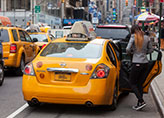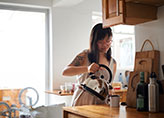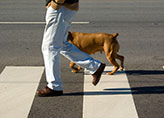3 Least restrictive practice
What have you done today that could be considered risky? You might have driven a car, crossed a road, made a cup of tea, taken the dog for a walk …
Figure 6 Risky activities?
- Do you know what risks you are taking every day?
- If someone suddenly told you that you aren’t allowed to drive because of the risks involved, what would you say?
- If you never took a risk what would happen? Would you grow as a person?
- Do you think of risk as positive or negative?
Often risks are associated with injury, loss, danger, damage or threat, and if a risk is perceived negatively, it can be used as an excuse to prevent people from doing something.
For example, some people may think that direct payments and personal budgets could put people more at risk of abuse and exploitation; others may feel they reduce risk by giving people greater control over their lives.
Taking risks is an everyday part of life – and life without risks would be very dull indeed. While it is important to try to identify risks in advance and reduce the likelihood of them happening, this shouldn’t be an excuse for preventing people from having choice and control over their lives.
Do you like to have a drink in the pub or to go for a meal with friends? It’s an opportunity to socialise and catch up with people, which is important to us for all sorts of different reasons. But you may have also been told that you need to lose weight, or you need to cut down on the amount of alcohol consumed as you are drinking more than the recommended limits than is good for you. You can weigh that up and make a choice – do you go to the pub/restaurant or do you stay at home and eat a healthy meal?
If that choice was taken away from you, how would you feel?
There has to be a balance and you need to ensure that you do not prevent someone you care for from having the right to do something simply because you do not believe it is good for them. You need to empower people and help them to access opportunities and take chances – and be positive about potential risks.
If you try to prevent people from doing anything that could be regarded as dangerous, you could potentially be preventing somebody from doing something they have the right to do.
Sometimes it can be difficult for carers to know where the boundaries lie in terms of what they can/can’t or should/shouldn’t do. In the next activity you will look at an example, and write down what you think your responsibilities would be in relation to your care of Sheila.
Activity 7
Read the scenario below and then answer the questions that follow.
Scenario
Imagine you work in a residential home, and one of the people you support is Sheila. Sheila has diabetes, which she manages through her diet. One of the things that this means is that she has to limit the amount of sugar that she eats as eating too much sugar can make her become unwell very quickly.
Sheila really enjoys going to the local shops: she likes to buy sweets and cans of cola and often eats and drinks more than she should, which makes her unwell. The people who support Sheila are worried about her health but when they try to talk to her about their worries she says, ‘It’s my choice’.
- What are the staff’s core responsibilities in supporting Sheila?
- What things might they try to better support Sheila?
Comment
The core responsibilities of staff would include:
- providing advice about diet
- supporting Sheila to make an informed choice
- supporting Sheila to access a dietician
- making sure that healthy choices are available for Sheila at meal times.
Ideas of what the staff might try to include in supporting Sheila is to look at alternatives; e.g. diabetic sweets, sugar-free drinks and giving her more information about her condition so that she can make better choices.
What the staff cannot do is:
- stop Sheila from buying cola and sweets
- take away Sheila’s cola and sweets or stop her eating them
- make Sheila choose the healthy choice on offer.




